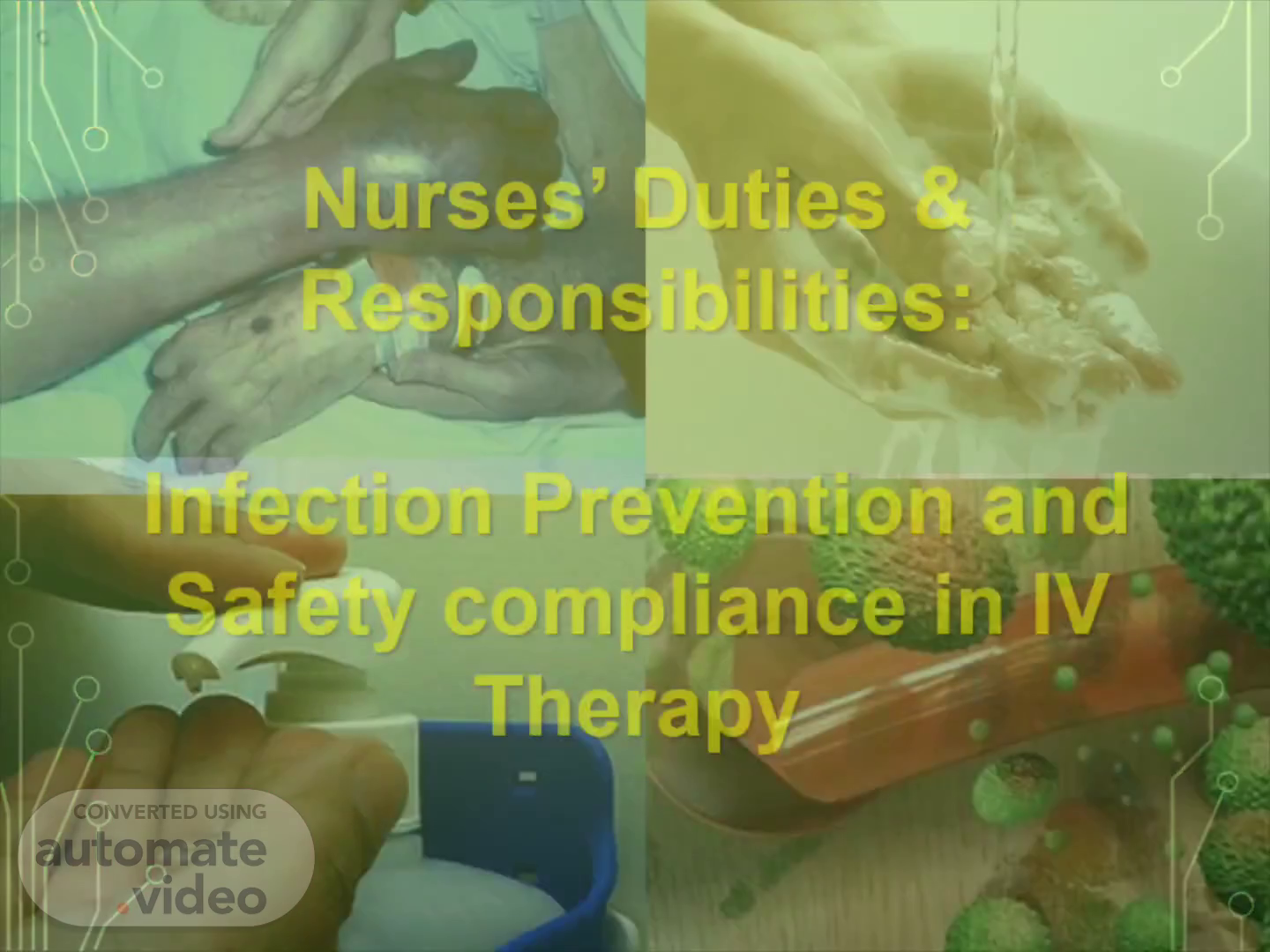
Preventing Nosocomial Intravascular related Device Infection
Scene 1 (0s)
[Audio] Nurses’ Duties & Responsibilities: Infection Prevention and Safety compliance in IV Therapy Today, we are going to discuss about nurse's duties and responsibilities and we will be focusing on the infection prevention and safety compliance in IV therapy..
Scene 2 (18s)
[Audio] General Objective To be able to discuss and apply the knowledge on the infection control, prevention and safety in IV Therapy. A 300 bed capacity. Almost all patients admitted have IV catheter making patients prone to developing a catheter related blood stream infection. ALOS=.
Scene 3 (41s)
[Audio] Healthcare-associated Infection: Localized or systemic condition that results from adverse reactions to the presence of an infectious agent Not present or incubating at the time of admission to the hospital. Develop within 48 hours after admission Diagnosis is based on the combination of clinical findings and laboratory results Nosocomial infection is clearly defined by the CDC in the NNIS system as a "localized or systemic condition (1) that results from adverse reaction to the presence of an infectious agent(s) or its toxin(s); and (2) that was not present or incubating at the time of admission to the hospital". Thus, infections that are unrelated to the admitting diagnosis that develop within 48 hours after admission are considered to be nosocomial infections. According to the CDC definitions, the diagnosis of nosocomial infection is made on the basis of a combination of clinical findings and the results of laboratory studies or other diagnostic testing..
Scene 4 (1m 45s)
[Audio] Healthcare-associated Infection 80% of healthcare associated infections: Urinary tract infection Surgical site infection Pneumonia Intravascular device-related bloodstream infection When a tube is placed in a large vein and not put in correctly or kept clean, it can become a way for germs to enter the body and cause deadly infections in the blood. The four most common nosocomial infections comprise approximately 80% of all nosocomial infections Intravascular device-related bloodstream infection: related to invasive procedures or the use of invasive devices.
Scene 5 (2m 28s)
[Audio] HAI One of the leading causes of death and increased morbidity 70% is caused by drug – resistant strains of bacteria Increase length of hospital stay One of the leading causes of death and increased morbidity for hospitalized patients Affects more than 2 million patients each year – or about 5% to 10% of hospitalized patients – leading to approximately 90,000 deaths per year Associated with higher healthcare costs, with an average cost of $14,000 to $38,000 per infection (based on three indicators:highest costs in terms of length of stay, charges, and mortality) Nearly 70% of nosocomial infections are caused by drug – resistant strains of bacteria.
Scene 6 (3m 20s)
[Audio] Route for Catheter Contamination Migration of skin organisms at the insertion site into the cutaneous catheter tract and along the surface of the catheter most common route of infection for short-term catheters Direct contamination of the catheter or catheter hub by contact with hands or contaminated fluids or devices.
Scene 7 (3m 39s)
[Audio] 3. Catheters might become hematogenously seeded from another focus of infection (less common) 4. Rarely, infusate contamination.
Scene 8 (3m 51s)
[Audio] Common pathogens of BSI Candida albicans Staphylococcus aureus Enterobacter cloaceae Staphylococcus epidermidis Pseudomonas aeruginosa Enterococcus fecalis.
Scene 9 (4m 4s)
[Audio] What leads to BSI? Poor IVT procedures Poor site maintenance IC Practices 50% National and State HAI Progress Report, March 2016 Based on National and State HAI Progress Report published in March 2016. With compliance to IC practices, BSI is decreased by 50%..
Scene 10 (4m 35s)
[Audio] PREVENTION OF INFECTION Wash hands – the most practical procedure for preventing cross – contamination (person to person).
Scene 11 (4m 48s)
[Audio] Hand Hygiene and Aseptic Technique Perform hand hygiene procedures before and after palpating catheter insertion sites before and after inserting, replacing, accessing, repairing, or dressing an intravascular catheter. Palpation of the insertion site should not be performed after the application of antiseptic, unless aseptic technique is maintained Maintain aseptic technique for the insertion and care of intravascular catheters. Source: Guidelines for the Prevention of Intravascular Catheter-Related Infections (2011).